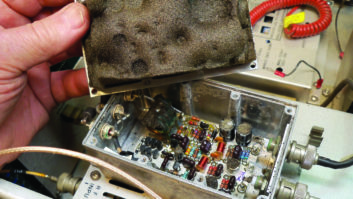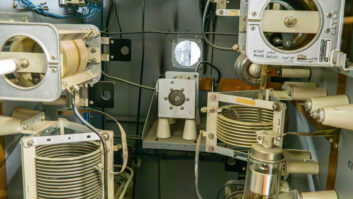Workbench contributor and engineer Duke Evans writes that he has repaired many a circuit board trace with bare wire. In his years of circuit board repairs, Duke has also noted that some older electrolytic capacitors do not have the top creases in the aluminum, and when they explode, they do so downward through the rubber base. This then blows a hole in the circuit board. The repair is not fun.
On one seriously damaged board, Duke was able to fill the hole with E-6000 epoxy from Tap Plastics, and had to do mucho wiring where the traces were blown apart. Fig. 1 shows two capacitors — one with the crease and one without it.

A good rule of thumb is to replace electrolytics every five to seven years. Older electrolytics may not explode but still cause squirrelly operation or poor audio response.
Shotgun replacement of the electrolytics ensures that everything is fresh. Observe the polarity of the electrolytic capacitors as you replace them.
***
Now, if you don’t have an electrolytic capacitor checker, WETA(TV)’s Bill Seabrook recommends the EDS-88A CapAnalyzer This instrument has saved Bill hours of time in identifying defective capacitors, without having to remove them from the circuit board.
In just a few minutes, this model permits checking a board with dozens of capacitors mounted on it. EDS no longer manufactures the CapAnalyzer but has licensed its manufacture to Merced Electronics The analyzer runs less than $250.
Again, when a capacitor ages, it can cause problems with the circuit’s operation. In video circuits, it can cause a fully scrambled picture. High-end audio, video and computer products use tantalum capacitors that can also become leaky by as much as 500 ohms. Computer motherboards are another user of electrolytics that must have super-low ESR (equivalent series resistance), or strange problems and freezing can occur.
The trick to locating bad capacitors in-circuit is not just to measure capacity, but instead, to measure equivalent series resistance and DC resistance in relation to capacitance. A perfect capacitor will measure as an open circuit at DC, and will display less AC resistance as the frequency across it increases. The CapAnalyzer 88 was the first device that would measure both DCR and ESR automatically.
If you don’t have a CapAnalyzer, add it to your test equipment wish list.
Thanks, Bill, for sharing this find with Workbench readers!
***
Believe it or not, some stations still use cart machines. A snag in using this decades-old technology, however, is replacing the pressure pads used on the old carts. Project engineer Dan Slentz found a working substitute for repairing the pressure pads on old carts.

Dan has seen a number of people asking for foam pads for the old Fidelipac-branded carts on Facebook, and was digging around and found that the right thickness “weather-seal foam” (not the dense “mushy foam,” but the stuff that is a lighter foam such as the roll pictured in Fig. 2) will work.
If you can find the roll in a 1/4-inch width, it’s a direct fit (when you cut the length to match). So all you have to do is remove the pad support (the metal bracket) and lightly sand off the old glue and clean with alcohol. Then cut this self-adhesive weather stripping foam to the right size and stick it on.
When searching for the weather-seal foam, make sure it is the “foam style” and not the “rubber type.” The rubber will stick to the back of the magnetic tape and not allow the cart tape to “flow” over the pad. The cheaper foam is smooth, like the original pad material. It’s got an adhesive on the one side, which makes it easy to apply to the metal piece that holds it in the cart (remember to scrape off and sand any remnant of the old pad before affixing the new), then maybe clean it with a little alcohol to make sure it’s perfectly clean. A close-up of a strip of the foam is seen in Fig. 3.

***
Since nearly everyone reading this has a smartphone that takes pictures, why not adopt a process used by Alpha Media’s Dale Lamm, DOE for WHBC in Canton, Ohio?
Dale combines pictures taken on his cell phone with maintenance tips and procedures, documenting problems he’s solved in both word and picture. It doesn’t take long to do, and the benefit to you or your assistant can be invaluable.
Contribute to Workbench. You’ll help fellow engineers and qualify for SBE recertification credit. Send tips and high-resolution photos to [email protected]. Fax to (603) 472-4944.
Author John Bisset has spent 48 years in the broadcasting industry and is still learning. He handles Western U.S. radio sales for the Telos Alliance. He is SBE certified and is a past recipient of the SBE’s Educator of the Year Award.







